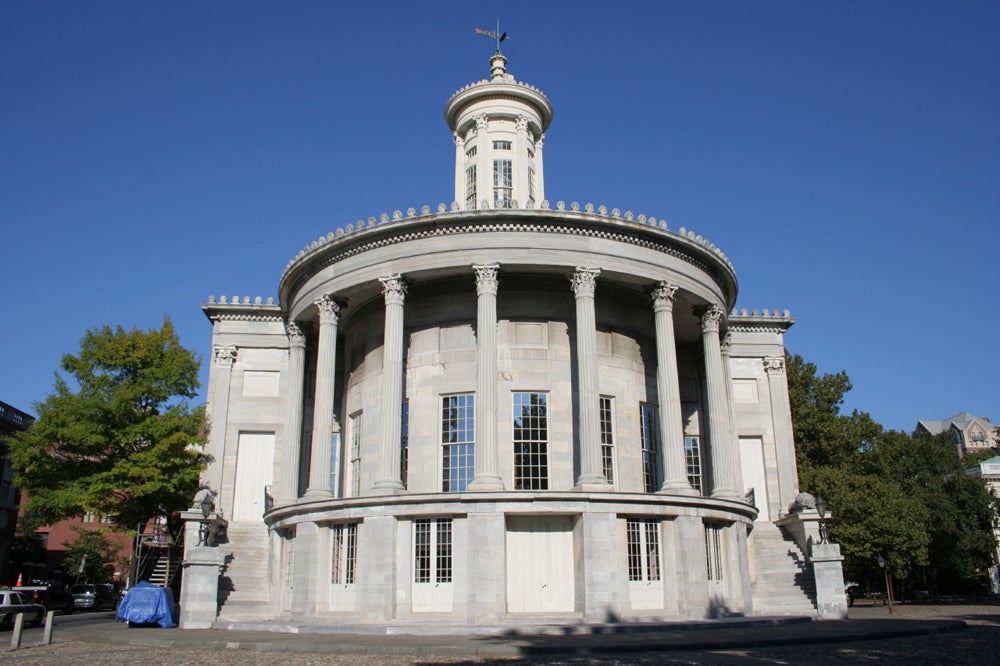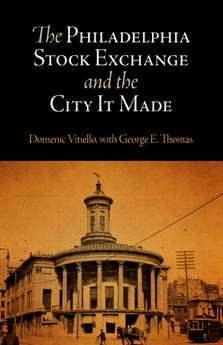Book review: The Philly Stock Exchange, and the city it left unfinished
The familiar battle between city planners and real estate developers is hardly a modern era phenomenon. In macro ways, it is as old as the United States republic – the planner a sort of artist to the developer as patron. The planners may speak for the people, but the developers, many of them skilled at economic populism, have an ever greater upper hand: access to capital.
Developers also have connections in high places, and tend to toss around the American mantle of progress like the proverbial manhole cover. In very clear ways, the birth of American capitalism and systemized trade between companies was the engine of the nation’s early development.
It was “politically engaged ‘insider’ financiers [who] effectively underwrote the networks of transportation, communication, and land development that urbanized the early United States,” Domenic Vitiello writes (with George E. Thomas) in his new book from the University of Pennsylvania Press, “The Philadelphia Stock Exchange and the City It Made.”
Later, the same heirs to the insiders and evolving networks of finance would underwrite modern urbanization – as well as the suburbanization schemes that would drain the city of many of its residents and businesses.
The book, at less than 200 pages (not counting appendices and notes), is a pleasantly brisk recounting of the history of America’s first stock exchange (it was founded in 1790) and the surprising number of ways it shaped the growth – and industrial decline – of Philadelphia.
Much of this surprise is due to the exchange’s low profile among its own citizens. However, any Philly sports fan will recognize a pattern illustrated in great detail here: innovation, originality, missed opportunities, an institution strong-armed by New York, short bursts of brilliance, and incredibly long periods of deterioration and stagnation.
For Philadelphians, the book provides an opportunity to learn about names that have long surrounded us but are missing from most standard history books: Drexel (Francis, Anthony), Morris (Robert, who went broke in 1798, “causing a minor national banking panic in the process”), Biddle (Thomas, Nicholas, etc.), Girard (Stephen), Widener (Peter), Stotesbury (Edward) and many others.
“Wars are run on debt, and the American Revolution was no exception,” the authors write. “Investing in the repayment of that debt at war’s end created the first full-scale securities market in the New World.” And in the wake of that effort? The national government decamped to New York, and then Washington, D.C. The financial center went north in the ensuing decade. “The peace-generated boomlet that nearly doubled the number of mercantile houses in Philadelphia in 1783 turned to ruin only a year later.”
Still, stocks and trading rebounded, along with interest-bearing public bonds. With it, though, came increasing opposition to speculation, the echoes of which seem never to end (Wall Street versus Main Street, in today’s parlance). “Critics of speculation – and of cities – abounded in early America, particularly among men who derived their wealth from the land and from slave agriculture, including George Washington, Thomas Jefferson, and James Madison.” Needless to say, the markets eventually won the day.
Sprinkled throughout the volume are consistent reminders that America’s financial past is inextricably linked to our more familiar history lessons. Consider, for example, that the Boston Tea Party was initiated at the London Coffee House at Front and High (now Market) streets. The coffee house was the precursor to the exchange, followed by the City Tavern at 2nd and Walnut.
In the 1800s, the exchange and its members invested in the backbone of industrial America, raising capital for railroads, factories, plants and mining concerns. The Civil War was thus also financed here, a stone’s throw from the Mason-Dixon Line. Afterwards, the modernizing of transportation infrastructure, utilities and real estate was capitalized through Philadelphia.
So were roads, planned and not. “The greatest financial success among early American internal improvements was not a grand waterway but a relatively short road,” the authors write. Thus was born, in 1792, the nation’s first major private turnpike, via the Philadelphia and Lancaster Turnpike Company, which capitalized and built a 62-mile precursor to Route 30 with $465,000, over two years, millions in today’s dollars.
Vitiello and Thomas teach city and regional planning and urban studies, respectively, at Penn. As Philadelphia lost its status as a world economic power during the decades of the first half of the 20th Century, it was no coincidence that the Philadelphia Stock Exchange was moldering from within, they write.
Nevertheless, though the city continued its deindustrialization and its population began a steady decline (one that has been halted only within the last two years or so), the Stock Exchange re-invented itself, staying relevant by specializing in foreign currencies, stock options and other derivatives, and by embracing electronic trading and other new technologies.
Two years ago, it was acquired by the Nasdaq. But it a full “century earlier, the Philadelphia Stock Exchange had ceased being a significant engine of urban economic development,” the authors write. “Its uneven though often remarkable successes in the last half-century belied its disconnection with the city around it. Other sorts of institutions – public-sector agencies, universities, medical systems, communications and real estate firms – became the main shapers and drivers of the urban economy.
“While it may be the next great American city because of its livable neighborhoods and vibrant downtown, most of its skyscrapers remain inhabited by branch offices of companies headquartered elsewhere. The great majority of students at the region’s seventy-some colleges and universities still leave upon graduation. Finally, in perhaps the most salient indication of the limited economic opportunities in Philadelphia, in 2006 the Census Bureau revealed that it had become the poorest big city in the United States, with one quarter of residents living below the dismally low federal poverty level.”
The Nasdaq-Philly exchange still employs a few hundred people at 19th and Market streets. Why do we even need it? The authors admit to having no good answers.
Which would be fine with a bit more a what’s-next effort. But they leave a bad taste in the mouth of a modern-day Philadelphia reader, calling the exchange a “‘sixth-borough’ institution,” solely because its CEO has commuted from Manhattan for more than a decade.
It’s one thing to see a careless, too-easy slight like that bandied about in a blog. It’s another to see it foul the final page of an otherwise excellent UPenn publication. Or perhaps, as a native of the Quaker City, I’m being a touch too sensitive.
Contact the writer at twalsh@planphilly.com.
WHYY is your source for fact-based, in-depth journalism and information. As a nonprofit organization, we rely on financial support from readers like you. Please give today.





